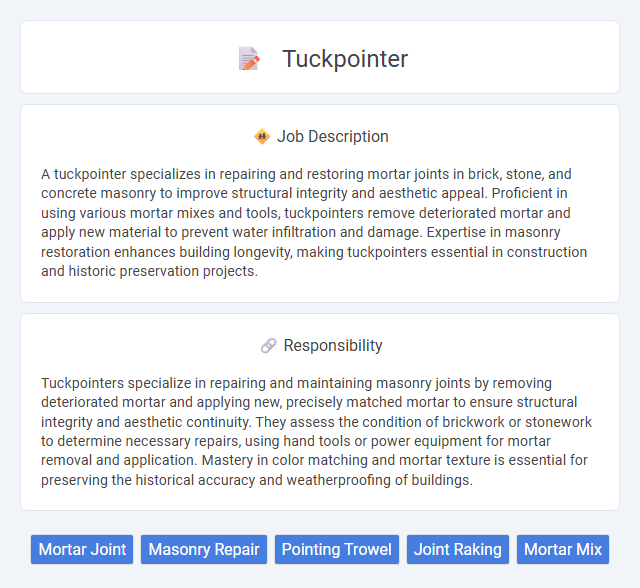
A tuckpointer specializes in repairing and restoring mortar joints in brick, stone, and concrete masonry to improve structural integrity and aesthetic appeal. Proficient in using various mortar mixes and tools, tuckpointers remove deteriorated mortar and apply new material to prevent water infiltration and damage. Expertise in masonry restoration enhances building longevity, making tuckpointers essential in construction and historic preservation projects.
Tuckpointer jobs may suit individuals who are physically fit and able to work with their hands in various weather conditions, as the role often involves repetitive motions and prolonged periods of standing or climbing. Candidates with a strong attention to detail and an interest in masonry restoration are more likely to excel, while those with limited physical stamina or discomfort working at heights might find this job challenging. The probability of job suitability increases for individuals who are safety-conscious and enjoy practical, outdoor work.
Qualification
Tuckpointers must possess expertise in masonry techniques, including knowledge of mortar mixtures, bricklaying, and stonework restoration. Certification or formal training in construction or masonry, along with proficiency in safety standards and equipment handling, significantly enhances job qualification. Experience with historic building preservation and strong attention to detail are essential for ensuring durable and visually appealing tuckpointing results.
Responsibility
Tuckpointers specialize in repairing and maintaining masonry joints by removing deteriorated mortar and applying new, precisely matched mortar to ensure structural integrity and aesthetic continuity. They assess the condition of brickwork or stonework to determine necessary repairs, using hand tools or power equipment for mortar removal and application. Mastery in color matching and mortar texture is essential for preserving the historical accuracy and weatherproofing of buildings.
Benefit
Tuckpointers likely enjoy improved building durability by repairing and maintaining mortar joints, which can extend the lifespan of structures. This job may offer steady demand since weather and time continuously impact brick and stonework, creating ongoing repair needs. Earnings could be enhanced by developing specialized skills in historic restoration and using advanced materials.
Challenge
The tuckpointer job likely involves significant challenges due to the precision required when repairing and restoring mortar joints in brick or stone masonry. Risks of working at heights and exposure to harsh weather conditions probably add complexity to the role. Mastery of specialized tools and techniques is often necessary to ensure structural integrity and aesthetic appeal.
Career Advancement
Tuckpointers specializing in masonry repair and restoration can advance their careers by gaining expertise in historic building preservation and advanced mortar techniques. Mastering the use of specialized tools and materials enables tuckpointers to qualify for higher-paying supervisory roles or project management positions within construction firms. Pursuing certifications from industry organizations, such as the Masonry Institute, enhances credibility and opens opportunities in commercial and residential restoration projects.
Key Terms
Mortar Joint
Tuckpointers specialize in repairing and restoring mortar joints between bricks or stones to enhance structural integrity and aesthetic appeal. Precise removal of deteriorated mortar followed by the application of new, color-matched mortar ensures weatherproofing and extends the lifespan of masonry surfaces. Expertise in mortar joint composition and curing techniques is essential for preventing water infiltration and maintaining the building's stability.
Masonry Repair
Tuckpointers specialize in masonry repair by removing damaged mortar joints and precisely filling them with premixed mortar to restore the structural integrity and aesthetic appeal of brick or stone surfaces. This skilled craft prevents water infiltration and deterioration, extending the lifespan of historic and modern masonry structures. Expert tuckpointing improves weather resistance and maintains property value by preserving the facade's original appearance.
Pointing Trowel
A tuckpointer expertly uses a pointing trowel to apply mortar precisely between bricks or stones, ensuring structural integrity and aesthetic appeal. The pointing trowel's narrow, tapered blade allows for detailed mortar shaping and smoothing, crucial for weatherproofing and restoring masonry joints. Mastery of this specialized tool enhances the durability and visual finish of brickwork in both new construction and restoration projects.
Joint Raking
Tuckpointers specialize in joint raking, a crucial step in masonry repair that involves carefully removing deteriorated mortar from brick or stone joints to a precise depth, typically about 3/4 inch. This process ensures a clean, uniform base for new mortar application, enhancing the durability and aesthetic of masonry structures. Expert joint raking by tuckpointers prevents damage to surrounding bricks, enabling strong, long-lasting repointing and weatherproofing of walls.
Mortar Mix
A tuckpointer specializes in repairing and restoring mortar joints between bricks and stones, using precise mortar mix formulations to match the original material's color and texture. Proper mortar mix composition, including sand, lime, and cement ratios, is critical for durability and weather resistance. Expertise in selecting and applying the right mortar mix ensures structural integrity and aesthetic consistency in masonry restoration projects.
 kuljobs.com
kuljobs.com